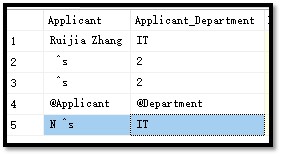Dear Support Team,
When i use DB connector to insert some values into MS SQL DB, i found unidentifiable Chinese characters in the DB. Meanwhile the English characters are correctly insert to MS SQL.
The column in MS SQL DB already set to nvarchar type.
Normally when we try to in insert Chinese character into MS SQL, i am following the syntax,
insert into tablename (column1, comuln2) values (N’Vaulue1’, N’Vaulue2’);
But this N seems not working in Tulip connector syntax?
(N’$Applicant$’,N’$Department$’,…

If i only put N, also met error below,

Could you please help me know how to transfer the message via UTF-8 or other format?
Or what else settings i missed?
Thanks in advance!














